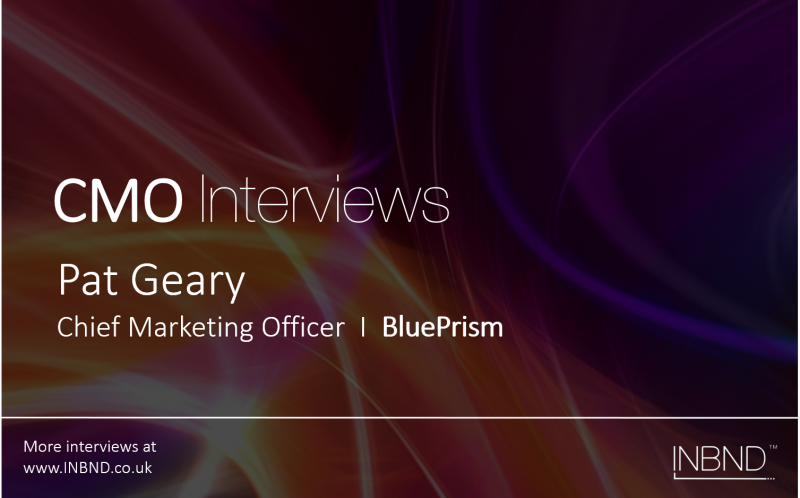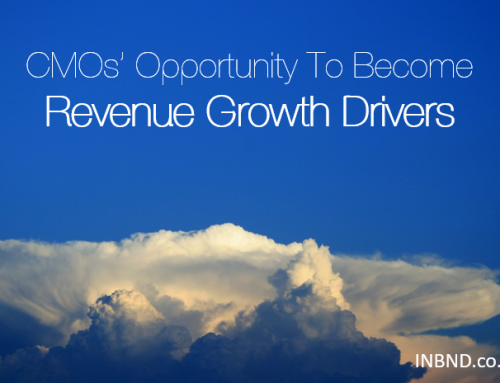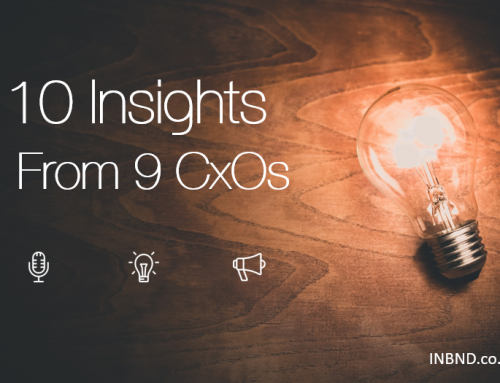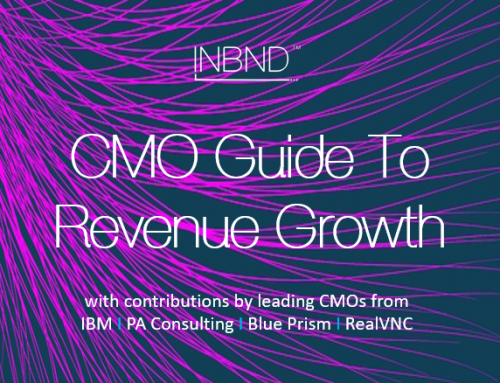The CMO Council and Deloitte found that the role and mandate of CMOs globally are changing towards a more revenue-oriented approach. However, the reality in 2017 is that often this is not reflected in practice. Read this interview with Pat Geary, CMO of Robotic Process Automation Software vendor BluePrism, about his view of what the revenue focus should be for today’s Chief Marketing Officers.
In a new series, INBND interviews CMOs from a variety of backgrounds and companies to dig deeper into CMO opinions, concerns, visions and strategies. Do they reflect the CMO Council’s findings and do CMOs agree with their apparent new mandate of growth?
In this interview with Pat Geary, INBND’s Managing Director Lev Cribb finds out more about the BluePrism Chief Marketing Officer’s views on marketing, growth and revenue – and where the modern CMO fits into the equation.

Hello Pat, perhaps we can start with yourself. What is your background and what path took you into the role of CMO?
I started playing with computers when I was 13 – which today sounds very late but in 1978 it was pretty young. We had a great inspirational teacher who saw the potential for computers and we won a competition to get the first Digital PDP 8 in a school in the UK. I remember seeing the badge on the computer and it was built in some far away world called Maynard Massachusetts USA which sounded so exciting– 10 years later I was Global Head of Marketing for Enterprise systems for Digital based in Maynard. In between I had earned an Honours Degree in Computer Science and joined Digital as a Graduate trainee in Software support, then sales and into marketing where I have been ever since. I had large Corporate Marketing roles until 1998 when I was tempted into an AI start up as CMO with a College friend, which was a major culture change but that worked out well. I then was CMO on the team that launched the world’s first Internet TV platform and then joined Blue Prism in 2008 where I have been CMO creating the new Robotic Process Automation (RPA) software category.
Can you tell us a bit more about your own revenue growth focus – did that come naturally or did it develop over time?
I started in pre-sales and sales, and quickly got into the commercial elements right from the start of my career. You’ve got to connect the value to what you see in the organisation. At the end of the day, it’s about the commercial proposition. What does the recipient of your services get? It comes back to that.
I guess I was lucky, as I went into a graduate training programme in my first company. What was good about that, was that it developed the people going through that programme, which is really important when you’re at the start of your career. The programme involved working in a lot of other departments, so I learned all about manufacturing, the supply chain, marketing etc. It was a very wide ranging exposure. That experience and background started me off with a commercial understanding of the value proposition, and that formed a basis for an understanding about growth opportunities.
In your opinion, who holds the responsibility for revenue growth: Sales, Marketing, or the C-Suite? And why?
It has to be a C-suite agenda as long term top line revenue growth is only possible if every other function is firing on all cylinders – all the department objectives have to ultimately align to revenue goals even if they are quality or efficiency based but of course sales and marketing at the sharper end on the process and marketing have to create the need and air cover for sales to engage in a consultative sales process and have scale and access through an active and capable partner channel.
When the CMO Council research finding show that, in practice, the majority of CMOs don’t (or can’t) prioritise a growth mandate, did that surprise you?
I guess it did. I think the role of the CMO has evolved from being only about the brand to being party of the revenue cycle. In FMCG it’s always been that way. Take Johnson & Johnson, for example, their marketers have always focused on the full width of commercial aspects. That’s always been their raison d’être, while for a long time high-tech marketing was more about Marketing Communications and the brand rather than intrinsically having a commercial focus.
In general terms, The CMO Council talks about lead generation and filling the funnel, but not enough is said about developing your value proposition. What is it you’re selling? With so many competitors and niches in the marketplace, the strategic development of a solid value proposition is an underserved area.
Larger corporations need to develop more sub-offerings, not rest on their laurels and cease innovating. Many larger organisations just monetise their audience, but they don’t innovate. Whereas, the very successful start-ups have a mixture of a desire to go to market in an innovative way, but also understand the value of marketing, positioning, packaging etc.
Those results from the CMO Council’s report are quite enlightening, although perhaps not entirely surprising at the end of the day.
What would be your advice to CMOs who don’t yet actively drive a growth agenda?
You’ve got to embed yourself in the commercial cycle, understand margins, profits and how it makes money etc. You need to understand where your competitors are operating. You have to be involved in the revenue mechanism and understand how that works – including profitability. Sit down with the CFO, learn and understand how those aspects work. I’ve been lucky in the companies I’ve been in, as the C-suite has always been focused on revenue growth, as well as the quality of the revenue. We always had a joint target to achieving that together. It’s the best way. You can have the best marketers in the world, but if you can’t create the value, it’s not worth anything. Very early on, you’ve got to realise the value you bring to clients, how much value they derive from using your products or services, and then share that with the rest of the world through case studies etc.
In your opinion, what is the best way for CMOs to influence and drive revenue growth?
A CMO has to be like a spider sitting at the middle of the company web with connections to all parts of the business and be the central conduit and custodian of the Brand, the proposition messaging, the references, nurturing customers, managing the Digital channels, creating demand, driving differentiation, creating news air cover, being the top of the SEO and generally creating public proof points that back the claims made by the sales force and finally the tone of voice of the company. The CMO has to drive the company to the Blue Ocean or an uncontested market place which is ultimately the way all successful businesses increase revenue and win their market.
What do you think are some of the main challenges for CMOs to drive revenue growth?
Again, if you understand the revenue cycle and your part in that, e.g. if you need a lot of inbound activity, then you need to focus on that. If you’re in a very high-value B2B services environment, then your website should be more geared more around awareness. Work more with analysts, such as Gartner etc. If you understand your business, then you know what helps drive revenue. It’s so different across all industries. Just driving traffic to your website, if you haven’t got the right value proposition, is like opening an empty shop. It’s a waste of time and resources.
How can CMOs ensure they drive growth and continue to fulfil the traditional role of the CMO as brand ombudsman and ambassador?
They have to be part of the commercial engine of the business, they can’t be seen as just “the press guy”. Every marketing goals should align back to a revenue goal and be directly measurable for impact and value against achieving that goal. In FMCG CMO’s are extremely commercial, they get deeply involved in all aspects of the revenue and profit chain down to where products are placed on shelves, their packaging, their segmentation and positioning – this is what Hi Tech CMO’s need to do – commercialise.
Given the growth and development of marketing technology, how technical should a CMO be today? Does a non-technical CMO have a disadvantage when it comes to driving revenue for a modern organisation?
I think it’s very useful to understand how a technology works but not vital as long as someone on your team does know – I see outrageous claims of what marketing automation technology can do but its only as useful as what you do with it and want to do with it. Keeping track of customers and building multi-dimensional marketing programs with them is for sure very useful once you get into the 1000’s of customers. It’s not possible to maintain a relationship and dialogue with large numbers of diverse customers potentially across the globe without employing marketing automation technology and systematic marketing methods.
What is the best business advice you have ever been given?
Listen to your sales people – Sometimes companies forget they have an incredible connection with the market through their sales teams that literally have their feet on the ground. Maybe it’s because I came from a sales background that I understood the full implication of that, many marketers are to abstracted from the reality of the sales process and also the other business functions. To market something you have to understand all of it.
What is your favourite business book, and why?
Blue Ocean Strategy by Renée Mauborgne and W. Chan Kim – It a great methodology for creating uncontested market spaces and whilst I also totally believe in the Moore books on Crossing the Chasm I think Blue Ocean is more helpful when setting the corporate direction and Moore is more helpful in execution.
Thanks for giving us your insight, Pat.
My pleasure, thank you.
For more information about BluePrism, go to www.blueprism.com, or connect with Pat Geary on Linkedin. Enjoyed this interview with Pat Geary? Read more CEO and CMO interviews on the INBND Blog.
About INBND Growth Marketing:
INBND provides Growth Marketing Consultancy Services to B2B organisations.
Lev Cribb started INBND to address one big problem: the disconnect between lead generation and sustainable revenue growth. Or in other words, between marketing and sales. He saw too many companies grow inspite of their lead generation efforts, not because of them. INBND brings the passion, expertise and focus to drive change in your organisation. Get in touch today and find out how a modern approach to revenue generation can help accelerate your growth.










